The Ultimate Guide to Product Management
CHAPTER 1
Why We Wrote This Guide
If you’re looking to understand what product management is and what good product management looks like this is the guide for you.
As the software and technology industry continues to grow at a rapid pace the demand for product managers continues to grow with it.
The correlation is due to business leaders realizing that product managers are the most equipped to meet customer expectations, reach business goals, and assist with digital transformation.
This is why the demand for product managers is growing and why many believe that we are in the “Golden Age of Product Management”.
A quick glance at Google Trends over the past 10 years will show an increase in the interest in the term “product management” and “product managers”.
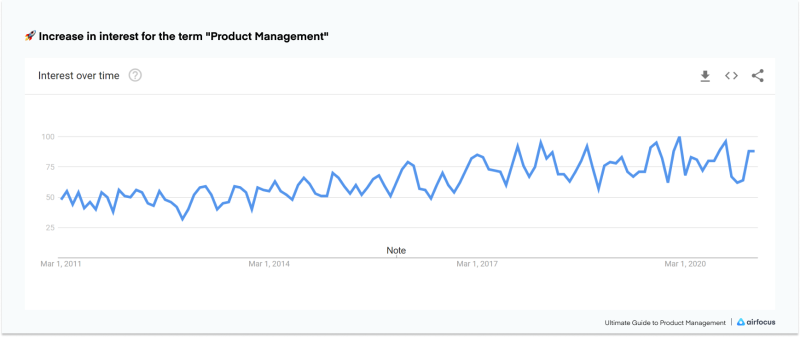
A 47% increase in the term “Product management” from March 2011 to March 2021. Google Trends
Despite this growth, there are many who work with product managers who lack an understanding of the role and can not confidently articulate in a few short sentences what exactly their colleagues are responsible for.
Can you define what product management is (and is not)?
Finding the right resources among the sea of blogs, books, articles, and videos on this topic can be difficult. We wanted to put together an ultimate guide to product management to give you the most important information you will need to distinguish what good product management looks like.
These are the topics that we will cover in this guide:
The history of product management
The function of product management
Why product management is vital to software companies
How product management is done effectively
Prioritization and product roadmaps
Common tools and frameworks used in product management
At the end of this guide you will know everything you need to know about the foundations of product management and more. Check out our resources on airfocus (especially our blog) to dive deeper into some of these topics.
Let’s get started!
CHAPTER 2
What is Product Management?
Product management is the practice of defining the “what” and “why” for the solutions that companies build, solutions that are meant to solve customer problems.
Factoring in business goals, available resources and constraints, customer problems, metrics, market information, and technological capabilities, product managers prioritize and make decisions that are meant to provide customer value and drive business impact.
While doing this they work to evangelize their solutions across their company and support the key stakeholders that they work with to ensure success.
If you’re asking yourself “but doesn’t the CEO or senior leadership also make decisions on what will be built?”. This is true, however, these decisions are normally based on information and inputs that they receive from their product team.
What product management is not
Product management is not project management
Later on in this guide we will discuss the key differences between the two but to be brief, product management involves strategy and delivery, while project management focuses mainly on delivery.
Product management is not marketing
There are many activities and responsibilities within product management that may overlap with marketing. These include crafting user personas, performing user interviews, writing copy for product and feature releases, and more.
The main function of marketing is to ensure that the right people are aware of the product and how it benefits them. This involves crafting marketing collateral, awareness programs, lead generation campaigns, and more.
Though a product management team would assist their marketing team in these efforts, the main responsibility of the product team is to ensure that they are building solutions that solve customer pain points and help them accomplish their goals.
The product team works to build the right solutions, the marketing team works to ensure that customers know that the solution exists and why they need it.
If you’ve heard of the role “product marketing manager”, this is a more specialized marketing role that attends to the product. Along with dealing with customer relations and gathering customer feedback, product marketing managers also ensure that companies have the right documentation, processes, and communication strategies for product launches (among other responsibilities).
Product management is not sales, customer success, or customer support
Sales, customer success, and customer support teams each have their specific responsibilities related to a product.
The sales team is responsible for selling the product to the right customers, customer success is responsible for ensuring that customers can successfully use the product, and customer support is responsible for assisting customers with addressing their issues and relaying this information to their team to resolve them.
Product managers assist each of these teams with fulfilling their responsibilities. For example:
Training the sales team on the product value propositions, use case(s), and joining sales calls with prospective customers
Joining customer calls with the customer success team to walk customers through the product roadmap and communicate how the evolving product will serve their interests
Regular meetings with the customer support team to understand the critical issues that customers are facing and ensuring that they are prioritized, resolved, and communicated to customers
Though product managers assist each of these teams, their roles and responsibilities expand outside of these specific roles. Keep in mind, product management is the practice of defining the “what” and “why” for the solutions that companies build, solutions that are meant to solve customer problems.
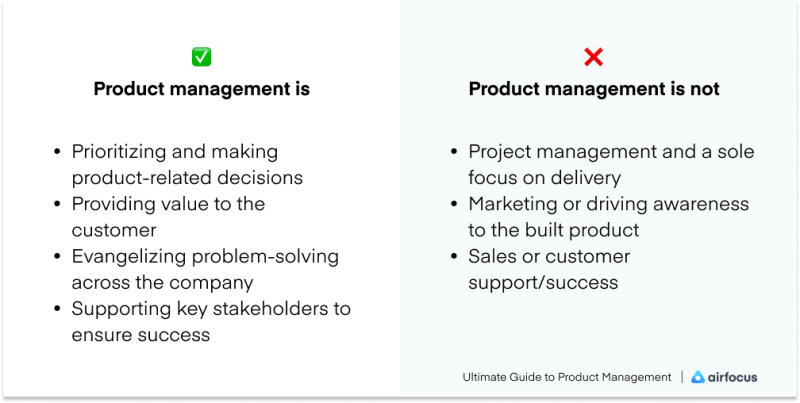
CHAPTER 3
What Does Effective Product Management Look Like?
Customer obsession
Along with knowing who target users and customers are, having a close relationship with them throughout research and discovery, testing, validating assumptions, and launching new solutions.
And continuously working with them to gather feedback to prioritize and inform future steps.
Technical
An understanding of how software and technology works.
Being technical does not mean that a product manager has to be a skilled developer, but rather that they have enough knowledge to have effective conversations with their development team so that they can help them make decisions and tradeoffs.
Stakeholder management
Product managers work and interact with multiple stakeholders. These stakeholders include the executive team of their business, developers, designers, sales, marketing, customer success, and others.
They work with these stakeholders to understand their needs and concerns, gather their inputs for product ideas and improvements, and to enable them to reach success with their role related to the product.
Effective product managers also lead these teams and act as the glue that keeps their departments focused around the product and the goals.
Data-driven decision making
Though product managers will make observations and their intuition may steer them towards a certain path, data is always collected and utilized when making decisions. This includes qualitative data: one-on-one interviews, product reviews, and focus groups.
Qualitative and quantitative data paired together is really powerful.
Effective prioritization
A product team will receive a long list of requests from multiple sources; customers requesting various items, sales requesting new functionality, customer success requesting additional capabilities, developers who want to improve the underlyings of the product, and more.
Taking in multiple inputs and considering the goals of the business, the resources available, the actions of competitors, market activity, effective product teams determine what will be worked on in the present, what will be worked on in the future, and what won’t be worked on at all. And of course why.
Strategy
Product management is a business strategy role. It is the function of business in technology, not the function of technology in business.
Everything that a product manager works on with their team, whether it is building a new product from inception, adding a minor enhancement, or fixing a bug, needs to tie into the goals of their business.
Effective product teams are always aware of what the main goals for their business are and can tie their product strategy and work directly to the business goals.
Industry expertise
Irrespective of the product effective product managers are experts of their industry.
While keeping an eye on their competitors they also keep a pulse on the market they operate within.
Product managers are required to define the “what” and validate it with the “why”. The more information they have the better the decisions they can make.
Working on a product for a business which operates within a particular market they keep a pulse on items such as:
Who are the new entrants in the space?
Is the market growing or shrinking?
What are the technological advancements that are taking place?
Where are investors investing their money?
...and more.
CHAPTER 4
What Does Effective Product Management NOT Look Like?
Project management
Product managers define solutions and work with their teams to bring it to life.
Upon launching a product they continue to work with customers to gather feedback, analyze data, collect inputs from their team, and then define how the product will evolve as they work through the product development process.
Effective product management is not project management, whereby a product is team solely concerned with building and shipping features. Strategy is a vital component of product management.
Defining the “how” for the team
Product managers define the “what” and “why”. As for the “how” this is defined by their team members.
When speaking to developers a product manager defines the solution, provides supporting documentation, works with product designers to provide visuals, and makes themselves available to clarify requirements. However, it is not the responsibility of a product team to tell their team “how” to implement their code.
Though a product manager will be involved in technical discussions, especially when discussing constraints and tradeoffs, they should not tell their team how to write or implement their code.
Let the specialists perform the work in the way that they know best.
Taking orders
Simply taking orders and directives from other stakeholders and immediately implementing them is not how product management is done. Even if these directives come from senior leadership (CEO), a very important customer (high ARR), or an irate VP.
Utilizing the disciplines of product management, product managers take inputs from stakeholders, understand the intention behind these inputs, and make decisions on what will be acted on based on multiple factors.
(Solely) data analysis
Analyzing data is a key function in product management because it is utilized to make decisions. Data is also utilized to track progress, prioritize, set goals, and plan for the future.
Though product managers utilize data for these purposes they do not live solely in data and metrics; gathering data, cleansing, inspecting, making models, and more.
Data analysis is an important skill and an activity that product teams perform, however product management involves much more.
A product manager should understand the story that the data is telling and utilize it to support product and business strategy.
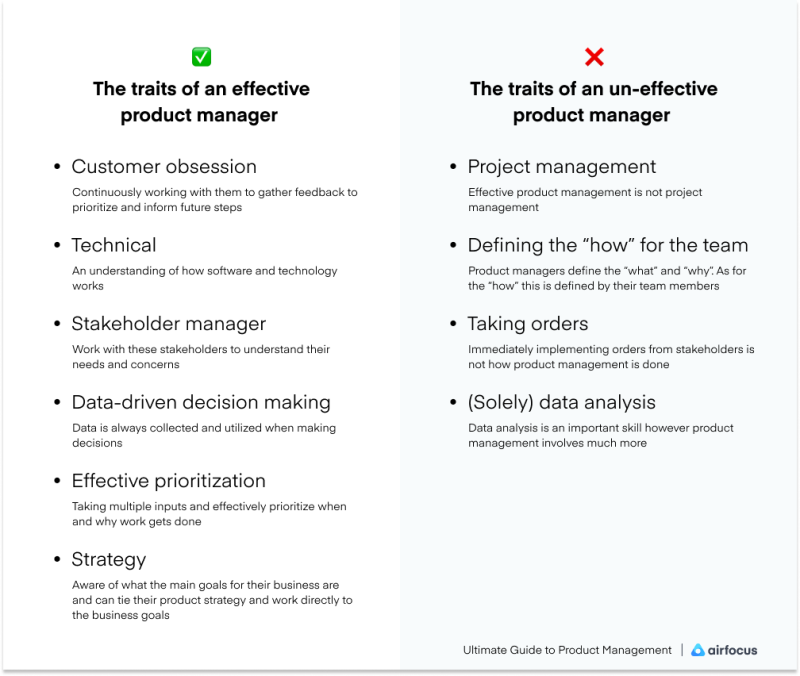
CHAPTER 5
The 3 Main Responsibilities of a Product Manager
Product managers understand customer and business problems, define solutions to solve these problems and help their business meet their objectives, and work with their stakeholders to achieve success (for the product and for their teams).
Everything that a product manager does ties into one of the following 3 responsibilities.
1. Staying customer focused
A product manager is the champion of their customer within their business.
They maintain a very close relationship with their users and customers. At any given time they should know the key problems that their customers are facing, their main asks for the product, who their target customers are, and more.
They also perform research and discovery with them, test prototypes, and gather feedback as they work through the product lifecycle.
2. Making data driven decisions
Product managers utilize both qualitative and quantitative data to make decisions that not only drive impact for users and customers, but also drive business impact.
While it is the job of a product manager to define the “what” and “why”, data is used to back up the “why” as well as the scope of the “what”.
Product managers also utilize data to set KPIs (Key Performance Indicators) to measure success and to inform future decisions.
3. Managing stakeholders
Stakeholder management includes managing and working effectively with stakeholders to achieve success.
This ranges from influencing senior leaders towards allocating budget towards a particular project, working with designers and developers to bring a product to life, and enabling stakeholders upon the launch of something new.
A big responsibility with a heavy workload
Product managers work with numerous stakeholders to accomplish business goals. Due to this and the many skills have at their disposal their role at times blends in with other roles and business functions.
This is one of the reasons why there is so much confusion regarding what exactly product managers do (“does the product manager craft the user personas for the product or does the marketing team?).
One very important thing to note about product management and product managers is that effective product managers are generalists.
Though they may specialize in certain areas, for example user experience design, project delivery, or data analysis, they have enough knowledge of the other functions in a business and software and technology.
Why is this important? So that they can communicate and work effectively with the multiple stakeholders in their business who also interact with the product and work towards its success.
A product manager must:
Understand the objectives and goals of their business and work with their stakeholders to ensure that they are met via their product.
Maintain close relationships with their users and customers to perform research, understand their pain points (problems that they are facing), and discover what delights them (to make product improvements).
Keep a pulse on the industry that they operate within to ensure that they are making the right decisions for their product and their business.
Monitor their competitors to ensure that their product and business continues to remain competitive (whether through product features, product design, tactics, etc.).
Work with their team members to ensure that they are enabled to perform their jobs to their best capacity.
Once the product team has defined the solution, they work with design and development to build it, and then enable their sales team by giving them the training, documentation, resources, and additional support so that they have the knowledge and resources to actually sell the product.
Due to the heavy workload and responsibilities effective product managers have a wide variety of skills and tools that they leverage.
These skills include:
Strategy
Data analysis
Communication
Sales
Marketing
UI/UX Design
Project management and agile methodologies
Technical (they understand how software and technology works)
...and more
CHAPTER 6
What Product Managers Don’t Do
Here are some common misconceptions about what the product manager role involves when in fact these are not part of a product manager’s roles and responsibilities.
Product managers are not mini-CEOs
This is an age-old question in the software and technology space, are product managers mini-CEOs?
While it is true that there are responsibilities that overlap between the two, the fact of the matter is that CEOs have two key things that product managers lack.
Product managers lack authority (CEOs do not)
Product managers do not make hiring and firing decisions. A CEO can fire a product manager however a product manager can not fire a CEO.
Product teams are part of the company similar to other departments and need to work with other departments and stakeholders to get things done. While executive level product managers will have a certain level of authority, a general product team does not have the same amount of authority as a CEO.
Product managers are not responsible for the overall success of the entire business, CEOs are
A product manager is responsible for the success of their product, in doing this they make decisions that lead to product success which also tie into business success. A CEO however is responsible for the overall success of the business.
The key difference here is that while a product manager is aligned with the business goals and works with their business as a whole to be successful, their general reach when it comes to decision making and (a limited amount of) authority does not go past the product or their product team.
Product managers don’t lead with authority
Product managers are leaders. Their company, departments, and stakeholders look to them to decipher what their customers want, what the market is looking for, and what they should build to remain competitive, reach their goals, and keep their customers happy.
While they work with various stakeholders within their company to reach common goals around the product, they are not the direct leader of these stakeholders.
This is one of the factors that makes being a product manager difficult at times.
For a product to be successful it requires more than just a good definition of what it is. Designers can make a well defined product, the development team can implement the definition and design, but if marketing and sales don’t play their part how will the product sell?
Product managers rely on their stakeholders to get things done. The product manager needs their team members more than their team members need them.
To get what they need skilled product managers lead with influence, not authority. Skilled product managers are able to influence their stakeholders to take a particular course of action.
They do this by utilizing data, understanding what the end goals of their stakeholders are, and ensuring that their initiatives align with these end goals.
Product managers who lead with authority rather than influence are doing their job wrong. And to be frank they may not last very long.
Product managers do not write code
Though this seems clear from the fact that the names of the roles are very different (“product manager” vs. “software developer”), when when you mention “product manager in the software industry” some assume that product managers are software developers.
By no means are we saying the product managers can’t code or shouldn’t learn how to. Did you know that only 5% of product managers know how to code?
Product managers define the “what” and “why” of a product and they work with specialists to determine the “how”. Software developers are specialists in bringing the definition of a product to life.
Product managers define the solution, software developers build the solution according to the definition.
Even if a product manager is skilled with software development if they are writing code alongside their developers on a daily basis then they are doing their job wrong.
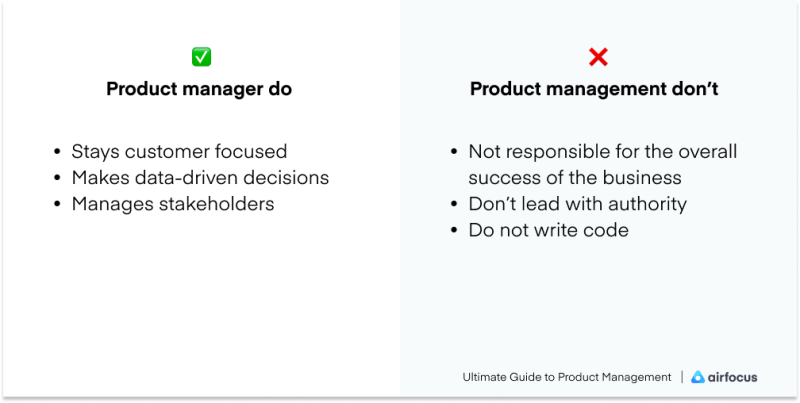
CHAPTER 7
Why is Product Management Important to SaaS Businesses?
Slack has more than 10 million daily active users and makes millions in revenue every year ($181.9 million in Q4 2020 alone).
Slack finished 2020 with 110,000 paying customers and 893 customers spending $100,000 annually on their product.
It goes without saying that It is an extremely popular messaging platform that teams all over the world rely on to communicate, connect, and manage their work. With numerous features that their users rely on, Slack’s app directory contains more than 2,000 apps and 750 bots as it continues to evolve.
As Slack continues to grow the company continues to receive and prioritize countless requests from their users and customers. Here is Slack’s public roadmap that communicates to developers specifically what they are working on.
There are numerous messaging apps available for companies to use besides Slack. These include: Google Chat, Microsoft Teams, Discord, Mattermost, Ryver, and more. However with these competitors there are many things that Slack has gotten right which lead teams to love and remain with their tool.
It goes without saying that as a business Slack has reached this level of success by solving the right problems for the right people.
Ilan Frank, current Head of Enterprise Product at Slack, said in an interview:
“That’s why it’s important to focus on the end user, and lots of software companies like Slack are doing so. One of the things people don’t realize about Slack is that we focus equally on the top down. What is going to be important for the enterprise buyer, what are the tools that are going to help my employees transform themselves to be more productive and innovative?”
This quote clarifies why product management is so vital to SaaS businesses. Utilizing the tools that are available, keeping a pulse on the market, speaking with customers and deeply understanding their pain points, the product management team defines what to build, for who, why, and work with their team to launch it while ensuring that it aligns with business goals.
When product management is done right the results are products and companies like Slack, Clubhouse, Coinbase, and TikTok.
CHAPTER 8
A Brief History of Product Management
It is important to know the history of how product management has developed over the years to better understand the role and function of product management and its similarity to other roles.
We previously published an article on the Pioneers of Product Management but here’s a brief history lesson.
When speaking about the history of product management Neil H. McElroy is the name that is usually mentioned. He is recognized as one of the main pioneers of product management.
Prior to becoming the Secretary of Defence for the USA and advising at Stanford University, he was the President at Proctor and Gamble.
In 1931 he wrote an 800-word memo describing what he termed as “brand men”. Though he wrote it as a justification for his company to hire more employees, he outlined some of the common responsibilities that product managers hold today.
The key responsibilities that he outlined for a brand man boiled down to them focusing on their brands (products). This involved defining and applying the formula for success for their brands to other regions, knowing the advertising and promotion of their products, and when brands were underperforming, uncovering weaknesses, making a plan, and working with management to address them. Sound familiar?
Bill Hewlett and David Packard (founders of Hewlett-Packard) were entrepreneurs that were heavily influenced by Neil H. McElroy and evolved the definition of “brand men” even further.
One practice implemented at HP was to structure the business into organizations focused around development, manufacturing, and sales. When each organization exceeded 500 people it would then be broken down further.
Along with making their teams easier to manage this practice also made it easier for them to focus. HP also implemented Kaizen (continuous improvement) and Genchi Genbutsu (real location, real thing - which means to go to the source and find the real information), two key principles that they learned from Toyota.
Kaizen and Genchi Genbutsu are important in understanding the development of product management because product teams are always looking for ways to improve their products and processes, and continuously work with their customers and users to acquire needed information, prioritize, and determine next steps to ensure that they are solving real problems.
Product management as a function initially focused on marketing (pricing, packaging, development) however it continued to evolve as the role became more prominent in the software industry.
Product development was also an initial key function of a product team.
As more technological advancements were made in the software industry and businesses faced increasing challenges it became clear that product managers had to focus on more than just marketing efforts, developing products, and the customer. They also needed to factor in the capabilities and goals of their business.
Prior to 2001 waterfall was the main methodology used to develop software. In 2001 however, with the authoring of the Agile Manifesto, agile became more prominent and utilized by product managers.
Agile methodologies helped establish how product managers could work more effectively with their developers while ensuring that products get built, and businesses and end users achieved value.
The four principles of the Agile Manifesto are:
Individuals and interactions over processes and tools
Working software over comprehensive documentation
Customer collaboration over contract negotiation
Responding to change over following a plan
Though product management as it is practiced today may vary from company to company the objectives of the role and its foundations are the same (irrespective of industry, size of a product team, and physical vs. digital product).
If the definition of the role is confusing and appears similar to that of marketing this is due to its history of initially focusing on the brand and the factors tied to it (product development, customer research, sales, and promotion).
CHAPTER 9
Roles Often Confused with Product Management
Product management vs. project management
One of the roles that “product” management often gets mistaken for is “project” management.
The confusion is partly valid as there are periods where the role of a product manager overlaps with that of a project manager. However, rarely does the role of a project manager overlap with that of a product manager.
Give this a try, call an experienced “product” manager a “project” manager and see how they respond.
Product management is concerned with both strategy and delivery, while project management is mainly concerned with delivery.
After gathering information from various sources (customers, users, market analysis, competitive benchmarking, goal setting, etc.) a product manager defines the “what” and “why” of a solution. This solution may be a complete product, a feature, or a minor enhancement within a product.
Once this solution has been defined a product manager works with their implementation team (consisting of product designers, developers, and QA) to bring the concept to life.
Writing documentation, attending meetings with their teams to clarify requirements, answering questions, testing the work to ensure that it meets acceptance criteria, and working with their team to ensure that the solution is shipped by the defined deadline.
Two of the key differences between product management vs. project management are that:
A project manager does not speak to users and customers to understand and prioritize their problems based on business goals, market activity, and available resources
Project managers do not define the solution
Project management is concerned with managing projects. Projects have a defined scope, defined resources for the specified project, and a specified timeline in which the project is performed and must be completed by.
A project manager works to ensure that the scope is completed by the defined deadline without exceeding the allotted resources. Project managers are concerned mainly with delivery, working with stakeholders to implement a solution.
Product managers define a solution, and thereafter wear the hat of a project manager when they plan the solution and work with their implementation team to bring it to life.
Throughout this process, if they deem fit, they may change the scope of the solution (as they learn more from users and customers), work with their internal team to evangelize the solution, and enable their team members as they prepare for launch.
Project managers manage delivery of a solution, product managers concern themselves with the strategy and delivery of their business and a solution.
Both roles have their importance in a business and there are transferable skills between them.
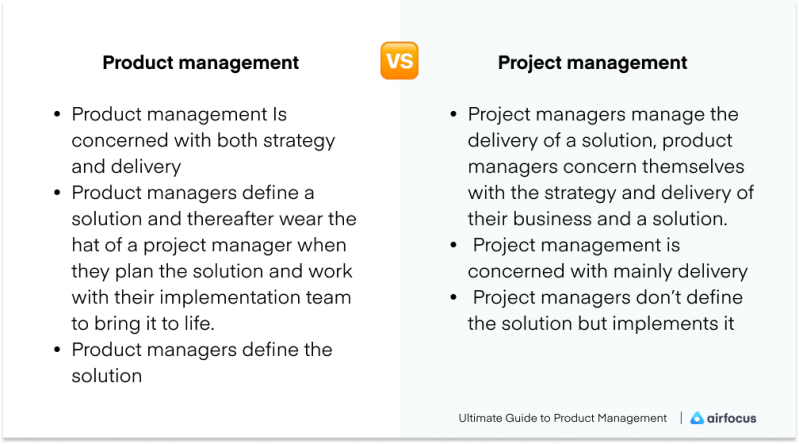
The product manager vs. the product owner
It is always beneficial to understand the repsonbilbites that team members hold so that you can work together effectively.
A product owner is another role that closely ties into product management. It is especially important to understand the differences between a product manager and a product owner because the roles may at times overlap, and because the two work closely together in a scrum team.
A product owner is the term for a product manager in a scrum team.
Scrum is a framework that teams use to develop products. Along with a set of key rituals that a scrum team must follow, it also contains values, tools, and defined roles that are meant to lead to product delivery and continuous improvement in the product delivery process.
The main responsibility of a product owner is to support their implementation team.
Their key tasks involve:
Working with the team to execute the sprint goals
Effectively prioritizing and maintaining the product backlog
Providing needed documentation and resources for team members
Working with their product manager to clarify requests
Communicating progress to their company
Working with their team to address issues that arise during development
So what is the key difference between a product owner and a product manager?
A product manager defines the strategy for the product. Product managers understand the goals of the business, perform research on customers, test and analyze competitor products, convince stakeholders in their business towards a particular strategy, analyze their market, define the product, and more.
While the product manager performs these tasks the product owner works with their implementation team to bring the defined product to life, keeping the product manager informed of progress and also receiving direction from the product manager should the product definition need revision based on constraints.
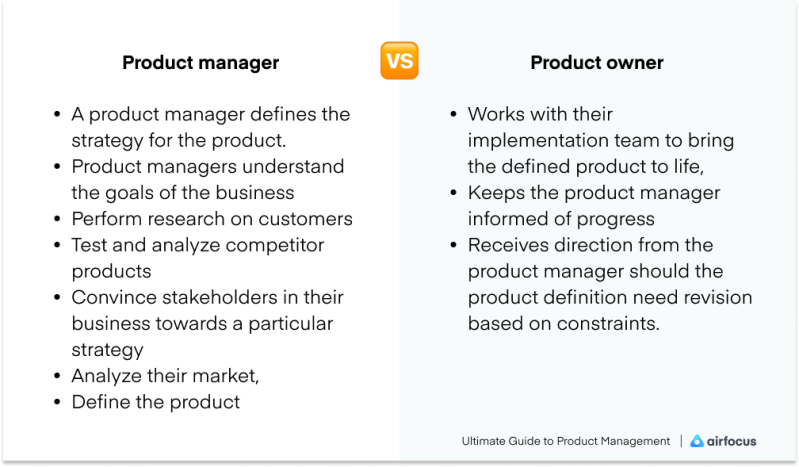
CHAPTER 10
Prioritization in Product Management
Why prioritization is hard
One of the key roles of a product team is to define what is going to be worked on. What makes this difficult are the numerous pieces of information that need to be gathered to prioritize effectively.
Inputs come from many different stakeholders, there are limited resources that are available, and there are business objectives that need to be met.
When an important customer asks for a new feature, the VP of Sales presses on an additional enhancement to meet sales targets, the customer success team continues to request that a bug gets fixed…
It is the product team that determines what gets done, when, and the justification (why).
Prioritization doesn’t stop at defining what needs to be done, it also includes the order in which items should be prioritized as well (we’ll get to roadmaps shortly).
Why product managers are the most equipped to prioritize
The product team is the most equipped to make these decisions because they have deep knowledge of customer pain points, the goals of their business, the different goals that their various internal stakeholders are working towards, the business constraints that are present, and industry activity, to say the least.
There are multiple tools and frameworks used by product managers for prioritization. Irrespective of the tool and method prioritization as an activity should be transparent; stakeholders should be involved in the process.
This way when decisions are made, even if stakeholders do not always get what they ask for (which they shouldn’t), at least they will understand the process towards the final decision and be fully invested in the defined strategy.
The two main factors for prioritization
The two main factors that are considered when prioritizing are value and effort.
Value is the benefit that customers will obtain from using the product (which can also lead to other results such as downloads, sales, or a high CSAT).
However it can also be tied to goals which a business will accomplish as well. This includes an increase in revenue, higher market share, and a stronger position in the market.
Effort is the time, people, and resources required to bring a solution to life. Factoring in everything required from inception, through implementation, to launch.
While a solution that is high value and low effort is the golden apple that businesses seek, product roadmaps contain initiatives that meet different scales of prioritization (high value. high effort and low value, low effort).
Low value, high effort initiatives do not make it onto the product roadmap (they are not worked on).
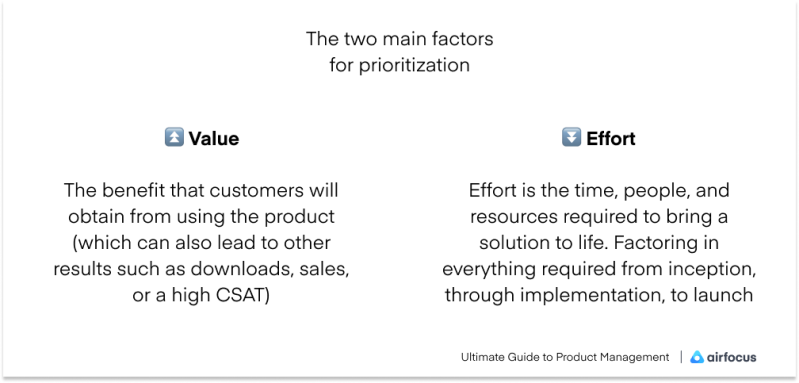
Prioritization methods
Some of the methods used for prioritization include:
Impact/Effort Matrix
Kano Model
MoSCoW Prioritization
RICE scoring
Buy-a-feature
Weighted Scoring
...and more.
Different companies use various methods. Irrespective of the method employed the end result is that stakeholders should have clarity on what will be worked on, what won’t be worked on, what will be saved for later, and the justification for each.
Check out the airfocus glossary to read more about these various methods.
CHAPTER 11
Product Discovery
Before we get to the product roadmap let’s talk about a key component of product management that leads up to prioritization and crafting the product roadmap, product discovery.
What is product discovery
As mentioned in our expansive glossary product discovery is the customer-centric process of determining whether or not a product or feature should be developed.
Product discovery is performed on both new products and existing products.
It is not the sole responsibility of a product manager to determine all of the features and solutions that will go into a product. This is because ideas and problems to solve come from many sources.
They can come from customers directly (or via channels such as feedback forms, customer support, surveys), developers, designers, stakeholders, and sometimes even competitors.
Testing a competitor's product may spark an idea for something to consider in their product.
Irrespective of the idea or source of the problem a product manager is responsible for performing discovery to validate whether the idea or solving a specific problem will actually benefit their customers and their business. Does it make “business” sense?
Performing product discovery
How product discovery is carried out may differ from team to team and company to company, however the overall goals are the same: to get a deeper understanding of what exactly customers are asking for (and why) and to have enough information to make a decision on what will and will not be worked on.
The first step of product discovery is empathy. This is a key skill required for product managers because they constantly need to put themselves in the shoes of their customers to understand how they use their product and their main pain points.
Product discovery also involves understanding, defining, and prioritizing the problem to be solved. And thereafter brainstorming ideas and testing them (with prototypes) to validate their hypothesis.
Throughout this process a product manager speaks directly with their target customers.
Whether they are in-person interviews, focus groups, or usability tests, product managers take opportunities to meet with their customers and understand how they are utilizing the product, its strong points, and its weaknesses.
Once discovery is complete then a product manager will prioritize which items they want to work on, which then leads to the product roadmap.
Check out our Quick Guide to Product Discovery to learn more about this topic.
CHAPTER 12
Roadmapping in Product Management
What is a product roadmap?
A product roadmap is a strategic document that communicates the product vision, the priorities of a business, and the plans and priorities for the product as time progresses.
While the responsibility of crafting the product roadmap ultimately falls on the product team, it is developed with input from other stakeholders and departments. The roadmap initiatives are derived as a result of prioritization efforts.
How to craft a product roadmap
Here are the general steps for crafting a product roadmap:
Set the business goals and objectives (OKRs)
Gather inputs form various sources
Prioritize the initiatives (based on value, effort, goals, etc.)
Add the initiatives that will be worked on to the roadmap with broad timelines for completion
Share the roadmap with stakeholders
Update the roadmap as initiatives progress
Internal vs. external roadmaps
Roadmaps come in many forms and serve different audiences for various purposes.
Internal roadmaps are used to communicate to internal stakeholders what the main product initiatives are, plans, and projects, and are used to determine resource allocation.
Internal roadmaps also assist teams in remaining focused (these are the main initiatives for this specific time period).
External roadmaps (normally shared with users and customers) communicate to customers how the product will evolve over a specific time period. Make sure to do the following when sharing roadmaps with customers and other external stakeholders:
Ensure that the initiatives have broad timelines for completion (no specific dates)
Make it clear to external stakeholders that the roadmap communicates the strategic focus for the product and is not meant to be interpreted as a project plan
Doing this will provide flexibility if items take longer than expected or get deprioritized due to changing priorities.
What are the common tools and frameworks that are used in product management?
There are multiple tools and frameworks that are utilized in product management. Some of these tools and frameworks are specific to product managers while others are used by the product team in general. A product team consists of product managers, designers, developers, and data analysts.
Product Management:
airfocus
Analytics:
Google Analytics
Mixpanel
Amplitude
Heap
Kiss Metrics
Prototyping:
Figma
InVision Studio
Miro
Adobe XD
Sketch
Customer feedback:
Pendo
Canny
SurveyMonkey
Intercom
Hubspot
Project/task management:
JIRA
Trello
ASANA
Pivotal Tracker
Basecamp
Prioritization frameworks:
Kano
Impact/effort matrix
Weighted scoring
RICE
MoSCoW
Product strategy:
OKRs
Customer Value Proposition Canvas
Jobs to Be Done
HEART
AARRR
Stakeholder communication:
Slack
Microsoft Teams
Workplace by Facebook
Hangouts Chat
Mattermost
Check out the airfocus glossary to learn more about these tools and frameworks.
What next?
Product management is a vital role in SaaS companies due to the need for people who can decipher and deliver what customers want, while also working towards reaching business goals with stakeholders.
While there are many who don’t have a comprehensive understanding of what product management is, now that you have read this guide you definitely don’t belong in thatcamp.
You now know what product management is (and is not), what the key responsibilities of product managers are, what good product management looks like, and how product managers prioritize and craft roadmaps.
To learn more about product management and dive deeper into the topics mentioned check out the airfocus blog. It is complete with knowledge, tools, and tricks from our team based on what works and is used by experienced professionals in the industry.

Too busy?
Download now & read later.
Get the PDF
